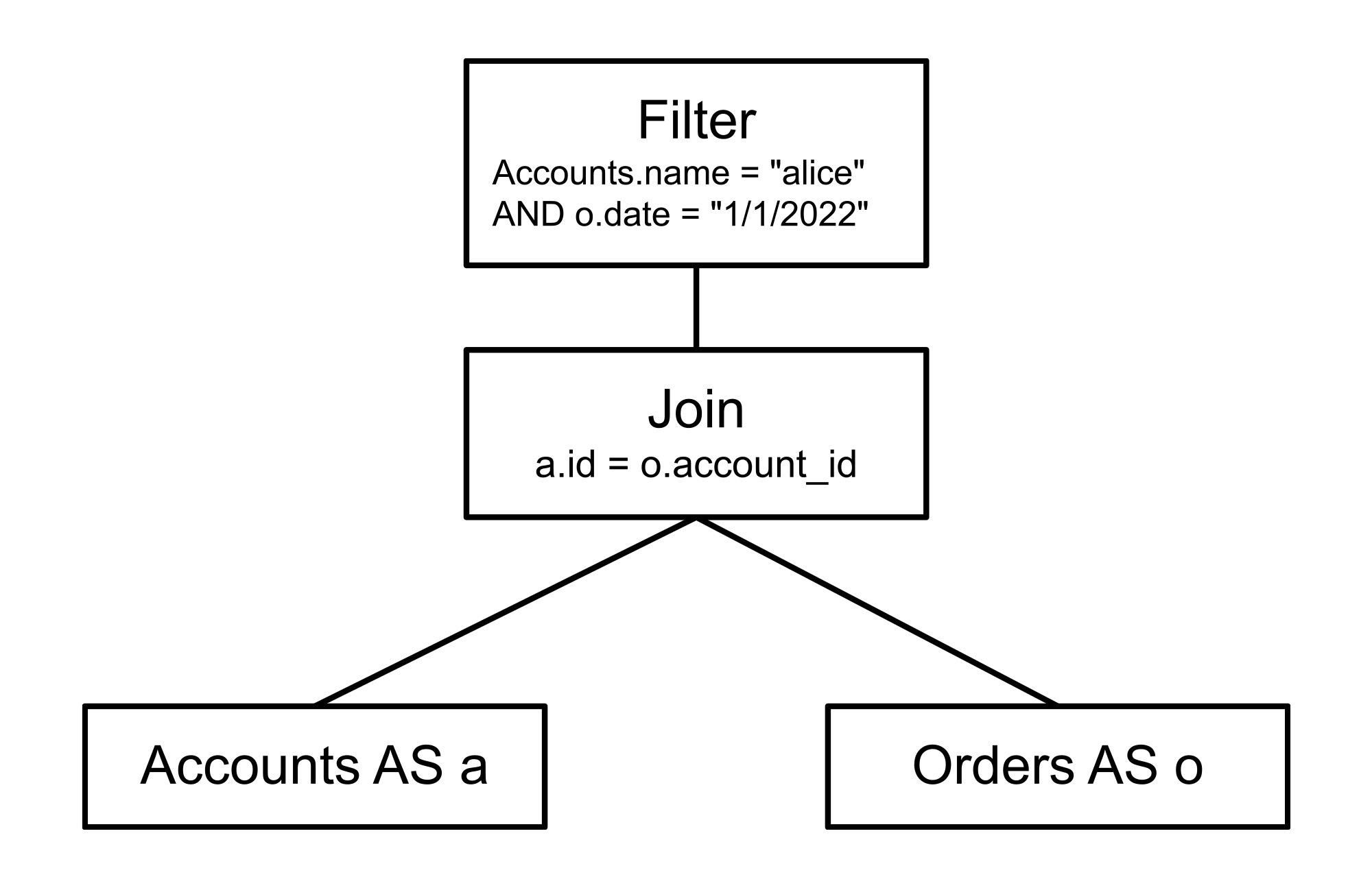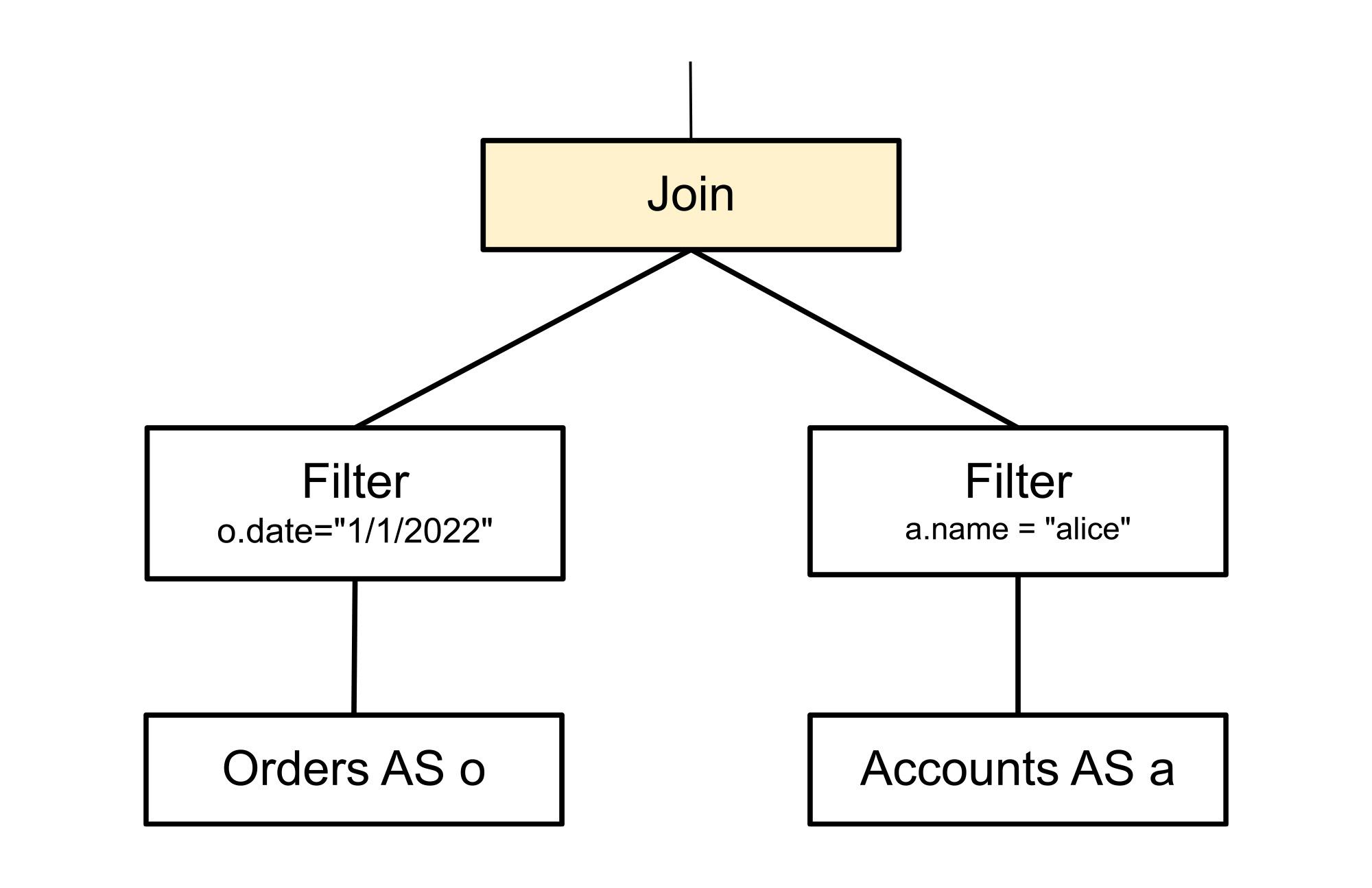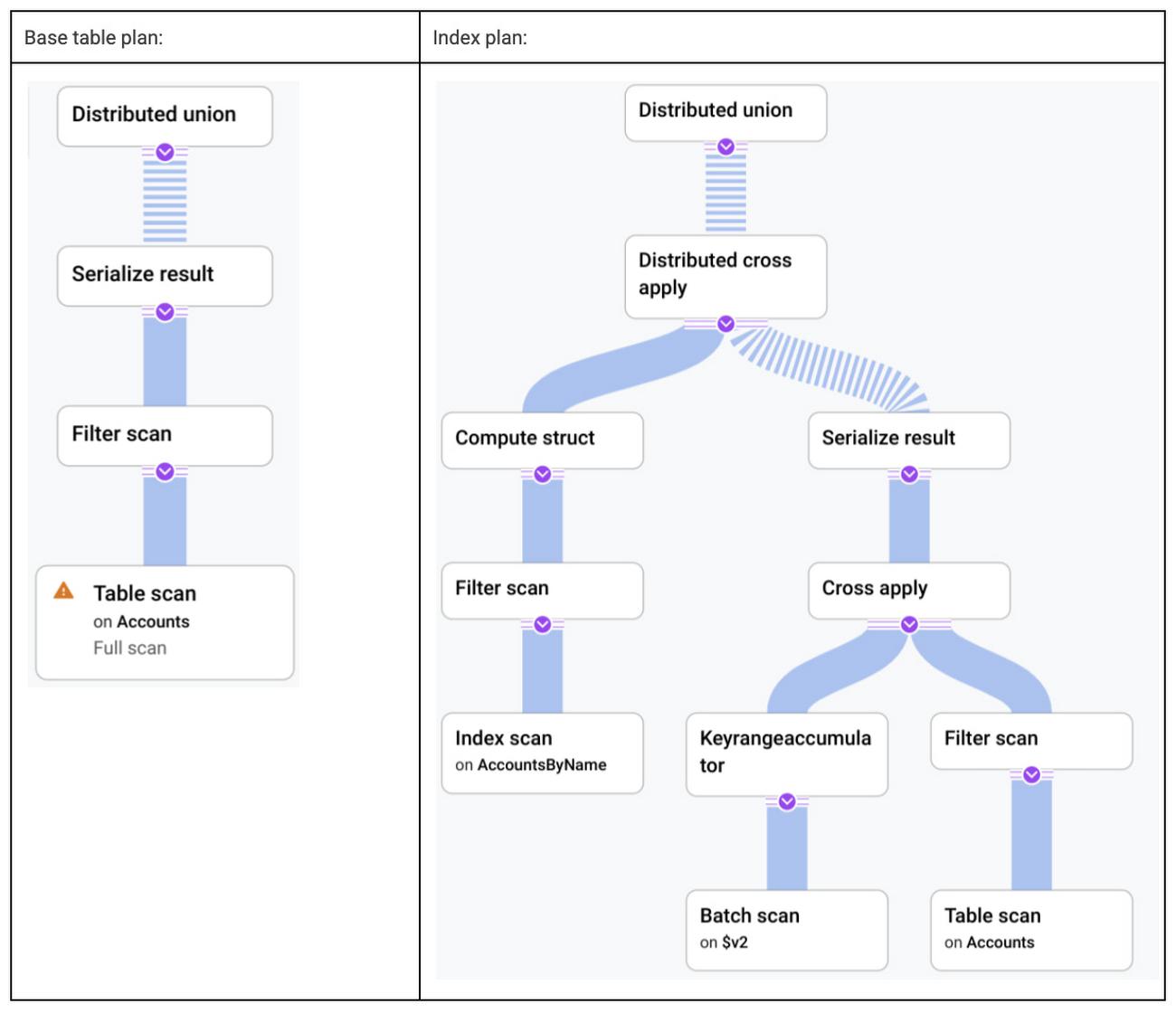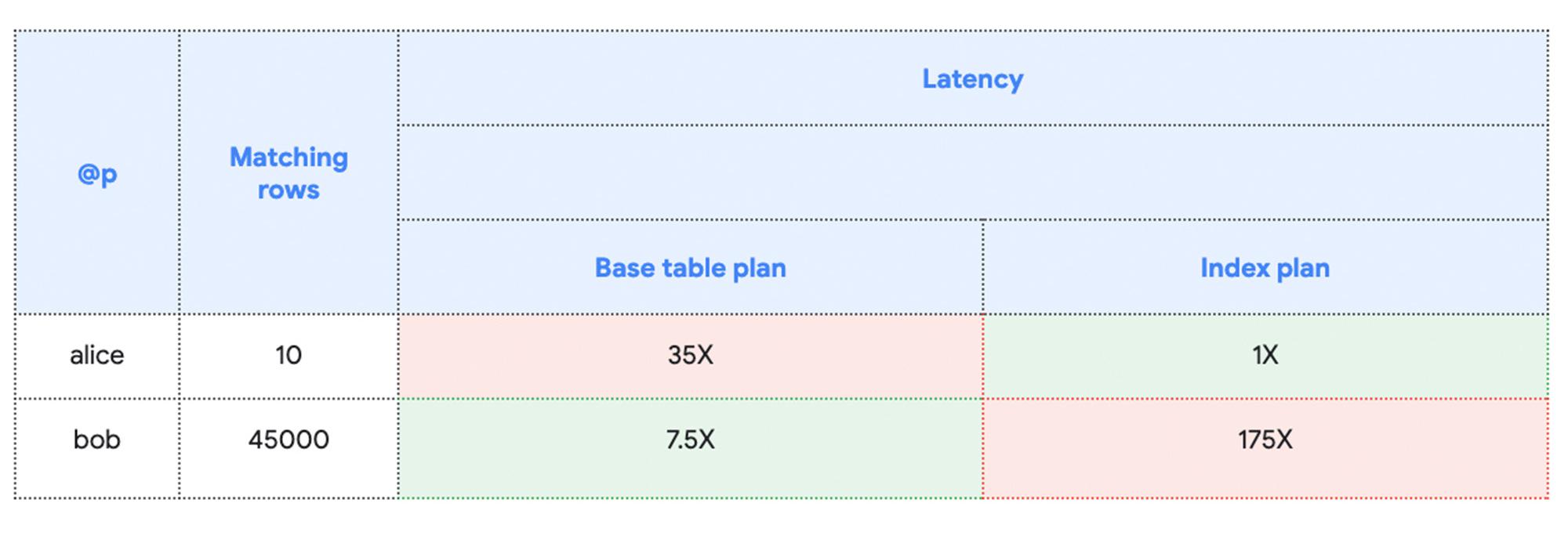
How does the Spanner query optimizer work?
Let’s start with the following example schema and query, using Spanner’s Google Standard SQL dialect.
Schema:
From our partners:
CREATE TABLE Accounts (
id STRING(MAX) NOT NULL,
name STRING(MAX) NOT NULL,
age INT64 NOT NULL,
) PRIMARY KEY(id);
CREATE INDEX AccountsByName ON Accounts(name);
CREATE TABLE Orders (
id STRING(MAX) NOT NULL,
account_id STRING(MAX) NOT NULL,
date DATE,
total INT64 NOT NULL,
) PRIMARY KEY(id);
SELECT a.id, o.order_id
FROM Accounts AS a
JOIN Orders AS o ON a.id = o.account_id
WHERE a.name = "alice"
AND o.date = "2022-1-1";

Example of a replacement rule
This rule pushes a filteroperation closer to the data that it is filtering. The rationale for doing this is two-fold:
- Pushing filters closer to the relevant data reduces the volume of data to be processed later in the pipeline
- Placing a filter closer to the table creates an opportunity to use an index on the filtered column(s) to scan only the rows that qualify the filter.
The rule matches the pattern of a filter node with a join node as its child. Details such as table names and the specifics of the filter condition are not part of the pattern matching. The essential elements of the pattern are just the filter with the join beneath it, the two shaded nodes in the tree illustrated below. The two leaf nodes in the picture need not actually be leaf nodes in the real tree, they themselves could be joins or other operations. They are included in the illustration simply to show context.


Cost-based optimization
There are big decisions about an execution plan for which no effective heuristics exist. These decisions must be made with an understanding of how different alternatives will perform. Hence the second stage of the query optimizer is the cost-based optimizer. In this stage, the optimizer makes decisions based on estimates of the latencies, or the costs, of different alternatives. Cost-based optimization provides a more dynamic approach than heuristics alone. It uses the size and shape of the data to calculate multiple execution plans. To developers, this means more efficient plans out-of-the-box and less hand tuning.
The architectural backbone of this stage is the extensible optimizer generator framework known as Cascades. Cascades is the foundation of multiple industry and open-source query optimizers. This optimization stage is where the more impactful decisions are made, such as which indexes to use, what join order to use, and what join algorithms to use. Cost-based optimization in Spanner uses several dozen algebraic transformation rules. However, rather than being replacement rules, they are exploration and implementation rules. These classes of rules have two steps. As for replacement rules, the first step is a pattern matching step. However, rather than replacing the original matched fragment with some fixed alternative fragment, in general they provide multiple alternatives to the original fragment.
Example of an exploration rule
The following exploration rule matches a very simple pattern, a join. It generates one additional alternative in which the inputs to the join have been swapped. Such a transformation doesn’t change the meaning of the query because relational joins are commutative, in much the same way that arithmetic addition is commutative. The content of unshaded nodes in the following illustration do not matter to the rule and they are shown only to provide context.


Example of an implementation rule
Once again the following implementation rule pattern matches a join but this time it generates two alternatives: apply join and hash join. These two alternatives replace the original logical join operation.


Cascades and the evaluation engine
The Cascades engine manages the application of the exploration and implementation rules and all the alternatives they generate. It calls an evaluation engine to estimate the latency of fragments of execution plans and, ultimately, complete execution plans. The final plan that it selects is the plan with the lowest total estimated latency according to the evaluation engine.
The optimizer considers many factors when estimating the latency of a node in an execution plan. These include exactly what operation the node performs (e.g. hash join, sort etc.), the storage medium when accessing data, and how the data is partitioned. But chief among those factors is an estimate of how many rows will enter the node and how many rows will exit the node. To estimate those row counts Spanner uses built-in statistics that characterize the actual data.
Why does the query optimizer need statistics?
How does the query optimizer select which strategies to use in assembling the plan? One important signal is descriptive statistics about the size, shape, and cardinality of the data. As part of regular operation, Spanner periodically samples each database to estimate metrics like distinct values, distributions of values, number of NULLs, data size for each column, and some combination of columns. These metrics are called optimizer statistics.
To demonstrate how statistics help the optimizer pick a query plan, let’s consider a simple example using the previously described schema.
Let’s look at the optimal plan for this query:
SELECT id, age FROM Accounts WHERE name = @p
- Base table plan: read all rows from
Accountsand filter out those whosenameis different from the value of parameter, @p. - Index plan: Read the rows of accounts where name is equal to @p from the
AccountsByNameindex. Then join the set with theAccountstable to fetch theagecolumn.
Let’s compare these visually in the plan viewer:

Accounts match the condition. For the sake of simplicity let’s suppose that 10 rows in Accounts have name = “alice”, while the remaining 45,000 rows have name = “bob”. The latency of the query with each plan might look something like, using the fastest index plan for alice as our baseline: 
Optimizer statistics collection
Spanner automatically updates the optimizer statistics to reflect the changes to the database schema and data. A background process recalculates them roughly every three days. The query optimizer will automatically use the latest version as input to query planning.
In addition to automatic collection, you can also manually refresh the optimizer statistics using the ANALYZE DDL statement. This is particularly useful when a database’s schema or data are changing frequently, such as in a development environment, where you’re changing tables or indexes, or in production when large amounts of data are changing, such as in a new product launch or a large data clean-up.
The optimizer statistics include:
- Approximate number of rows in each table.
- Approximate number of distinct values of each column and each composite key prefix (including index keys). For example if we have table
Twith key{a, b, c}, Spanner will store the number of distinct values for{a},{a, b}and{a, b, c}. - Approximate number of NULL, empty and NaN values in each column.
- Approximate minimum, maximum and average value byte size for each column.
- Histogram describing data distribution in each column. The histogram captures both ranges of values and frequent values.
For example the Accounts table in the previous example has 45,010 total rows. The id column has 45,010 distinct values (since it is a key) and the name column has 2 distinct values (“alice” and “bob”).
Histograms store a small sample of the column data to denote the boundaries of histogram bins. Disabling garbage collection for a statistics package will delay wipeout of this data.
Query optimizer versioning
The Spanner development team is continuously improving the query optimizer. Each update broadens the class of queries where the optimizer picks the more efficient execution plan. The log of optimizer updates is available in the public documentation.
We are doing extensive testing to ensure that new query optimizer versions select better query plans than before. Because of this, most workloads should not have to worry about query optimizer rollouts. By staying current they automatically inherit improvements as we enable them.
There is a small chance, however, that an optimizer update will flip a query plan to a less performant one. If this happens, it will show up as a latency increase for the workload.
Cloud Spanner provides several tools for customers to address this risk.
Spanner users can choose which optimizer version to use for their queries. Databases use the newest optimizer by default. Spanner allows users to override the default query optimizer version through database options or set the desired optimizer version for each individual query.
New optimizer versions are released as off-by-default for at least 30 days. You can track optimizer releases in the public Spanner release notes. After that, the new optimizer version is enabled by default. This period offers an opportunity to test queries against the new version to detect any regressions. In the rare cases that the new optimizer version selects suboptimal plans for critical SQL queries, you should use query hints to guide the optimizer. You can also pin a database or an individual query to the older query optimizer, allowing you to use older plans for specific queries, while still taking advantage of the latest optimizer for most queries. Pinning optimizer and statistics versions allows you to ensure plan stability to predictably rollout changes.
In Spanner the query plan will not change as long the queries are configured to use the same optimizer version and rely on the same optimizer statistics. Users wishing to ensure that execution plans for their queries do not change can pin both the optimizer version and the optimizer statistics.
To pin all queries against a database to an older optimizer version (e.g. version 4), you can set a database option via DDL:
ALTER DATABASE MyDatabase SET OPTIONS (optimizer_version = 4);
@{OPTIMIZER_VERSION=4} SELECT * FROM Accounts;
Optimizer statistics versioning
In addition to controlling the version of the query optimizer, Spanner users can also choose which optimizer statistics will be used for the optimizer cost model. Spanner stores the last 30 days worth of optimizer statistics packages. Similarly to the optimizer version, the latest statistics package is used by default, and users can change it at a database or query level.
Users can list the available statistics packages with this SQL query:
SELECT * FROM INFORMATION_SCHEMA.SPANNER_STATISTICS
ALTER STATISTICS <package_name> SET OPTIONS (allow_gc=false);
ALTER DATABASE <db>
SET OPTIONS (optimizer_statistics_package = "<package name>");
@{OPTIMIZER_STATISTICS_PACKAGE=<package name>} SELECT * FROM Accounts;
Get started today
Google is continuously improving out-of-the-box performance of Spanner and reducing the need for manual tuning. The Spanner query optimizer uses multiple strategies to generate query plans that are efficient and performant. In addition to a variety of heuristics, Spanner uses true cost-based optimization to evaluate alternative plans and select the one with the lowest latency cost. To estimate these costs, Spanner automatically tracks statistics about the size and shape of the data, allowing the optimizer to adapt as schemas, indexes, and data change. To ensure plan stability, you can pin the optimizer version or the statistics that it uses at the database or query level.
Learn more about the query optimizer or try out Spanner’s unmatched availability and consistency at any scale today for free for 90 days or as low as $65 USD per month.
By: Campbell Fraser (Software Engineer) and Vlad Lifliand (Software Engineer)
Source: Google Cloud Blog
For enquiries, product placements, sponsorships, and collaborations, connect with us at [email protected]. We'd love to hear from you!
Our humans need coffee too! Your support is highly appreciated, thank you!








